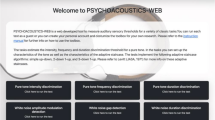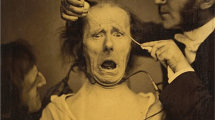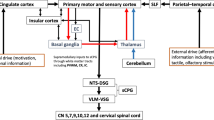Abstract
Aging impairs the control of many skilled movements including speech. The purpose of this paper was to investigate whether young and older adults adapt to lower lip perturbations during speech differently. Twenty men (10 young, 26 ± 3 years of age; 10 older, 60 ± 9 years of age) were requested to repeat the word (“papa”) 300 times. In 15% of the trials, the subjects experienced a mechanical perturbation on the lower lip. Displacement and neural activation (EMG) of the upper and lower lips were evaluated. Perturbations to the lower lip caused a greater increase in the maximum displacement of the lower lip for older adults compared with young adults (34.7 ± 19% vs. 13.4 ± 17%; P = 0.017). Furthermore, young adults exhibited significantly greater 30–100 Hz normalized EMG power for the lower lip compared to the upper lip (P < 0.005). In young adults, changes from normal to perturbed trials in the 30–50 Hz frequency band of the EMG were negatively correlated to the changes from normal to perturbed trials in the lower lip maximum displacement (R 2 = 0.48; P = 0.025). It is concluded that young adults adapt better to lower lip perturbations compared with older adults and that the associated neural activation strategy of the involved muscle is different for the two age groups.






Similar content being viewed by others
References
Addison PS (2002) The illustrated wavelet transform handbook. Taylor and Francis Group, New York
Amerman JD, Parnell MM (1990) Auditory impressions of the speech of normal elderly adults. Br J Disord Commun 25:35–43
Ballard KJ, Robin DA, Woodworth G, Zimba LD (2001) Age-related changes in motor control during articulator visuomotor tracking. J Speech Lang Hear Res 44:763–777
Brown P (2000) Cortical drives to human muscle: the Piper and related rhythms. Prog Neurobiol 60:97–108
Bugnariu N, Sveistrup H (2006) Age-related changes in postural responses to externally- and self-triggered continuous perturbations. Arch Gerontol Geriatr 42:73–89
Christou EA, Neto OP (2010) Identification of oscillations in muscle activity from surface EMG: reply to Halliday and Farmer. J Neurophysiol 103(6):3548
Christou EA, Tracy BL (2005) Aging and motor output variability. In: Movement system variability. Human Kinetics, Champaign, pp 199–215
Christou EA, Poston B, Enoka JA, Enoka RM (2007) Different neural adjustments improve endpoint accuracy with practice in young and old adults. J Neurophysiol 97:3340–3350
Chung SG, Van Rey EM, Bai Z, Rogers MW, Roth EJ, Zhang LQ (2005) Aging-related neuromuscular changes characterized by tendon reflex system properties. Arch Phys Med Rehabil 86:318–327
Doumas M, Rapp MA, Krampe RT (2009) Working memory and postural control: adult age differences in potential for improvement, task priority, and dual tasking. J Gerontol B Psychol Sci Soc Sci 64:193–201
Galganski ME, Fuglevand AJ, Enoka RM (1993) Reduced control of motor output in a human hand muscle of elderly subjects during submaximal contractions. J Neurophysiol 69:2108–2115
Goodmurphy CW, Ovalle WK (1999) Morphological study of two human facial muscles: orbicularis oculi and corrugator supercilii. Clin Anat 12:1–11
Gracco VL, Abbs JH (1985) Dynamic control of the perioral system during speech: kinematic analyses of autogenic and nonautogenic sensorimotor processes. J Neurophysiol 54:418–432
Grimbly G, Saltin B (1983) The ageing muscle. Clin Physiol 13:209–218
Grinsted A, Moore JC, Jevrejeva S (2004) Application of the cross wavelet transform and wavelet coherence to geophysical time series. Nonlinear Processes Geophys 11:561–566
Hubley-Kozey C, Deluzio K, Dunbar M (2008) Muscle co-activation patterns during walking in those with severe knee osteoarthritis. Clin Biomech (Bristol, Avon) 23:71–80
Ito T, Gomi H (2007) Cutaneous mechanoreceptors contribute to the generation of a cortical reflex in speech. Neuroreport 18:907–910
Kamen G, Sison SV, Du CC, Patten C (1995) Motor unit discharge behavior in older adults during maximal-effort contractions. J Appl Physiol 79:1908–1913
Karlsson S, Carlsson GE (1990) Characteristics of mandibular masticatory movement in young and elderly dentate subjects. J Dent Res 69:473–476
Lexell J, Downham D (1992) What is the effect of ageing on type 2 muscle fibres? J Neurol Sci 107:250–251
Marzullo AC, Neto OP, Ballard KJ, Robin DA, Christou EA (2009) Age-associated differences in neuromotor adaptation following lower lip perturbations. In: 2009 Annual Neuroscience Symposium on Alzheimer’s Disease. College Station, TX
Menant JC, Steele JR, Menz HB, Munro BJ, Lord SR (2009) Effects of walking surfaces and footwear on temporo-spatial gait parameters in young and older people. Gait Posture 29:392–397
Morrison JH, Hof PR (2007) Life and death of neurons in the aging cerebral cortex. Int Rev Neurobiol 81:41–57
Muller EM, Abbs JH (1979) Strain gauge transduction of lip and jaw motion in the midsagittal plane: refinement of a prototype system. J Acoust Soc Am 65:481–486
Myers LJ, Lowery M, O’Malley M, Vaughan CL, Heneghan C, St Clair Gibson A, Harley YX, Sreenivasan R (2003) Rectification and non-linear pre-processing of EMG signals for corticomuscular analysis. J Neurosci Methods 124:157–165
Nardone A, Siliotto R, Grasso M, Schieppati M (1995) Influence of aging on leg muscle reflex responses to stance perturbation. Arch Phys Med Rehabil 76:158–165
Neto OP, Christou EA (2010) Rectification of the EMG signal impairs the identification of oscillatory input to the muscle. J Neurophysiol 103:1093–1103
Neto OP, Baweja HS, Christou EA (2010) Increased voluntary drive is associated with changes in the common oscillations from 13–60 Hz of interference but not rectified electromyography. Muscle Nerve [Epub ahead of print]. doi:10.1002/mus.21687
Pavol MJ, Pai YC (2007) Deficient limb support is a major contributor to age differences in falling. J Biomech 40:1318–1325
Pereira R, Schettino L, Machado M, Silva PAV, Neto OP (2010) Task failure during standing heel raises is associated with increased power from 13 to 50 Hz in the activation of triceps surae. Eur J Appl Physiol doi:10.1007/s00421-010-1498-3
Shaiman S (2002) Articulatory control of vowel length for contiguous jaw cycles: the effects of speaking rate and phonetic context. J Speech Lang Hear Res 45:663–675
Shea CH, Park JH, Braden HW (2006) Age-related effects in sequential motor learning. Phys Ther 86:478–488
Sung PS, Park H (2009) Gender differences in ground reaction force following perturbations in subjects with low back pain. Gait & Posture 29:290–295
Torrence C, Compo GP (1998) A practical guide to wavelet analysis. B Am Meteorol Soc 79:61–78
Wohlert AB (1996) Reflex responses of lip muscles in young and older women. J Speech Hear Res 39:578–589
Wohlert AB, Smith A (1998) Spatiotemporal stability of lip movements in older adult speakers. J Speech Lang Hear Res 41:41–50
Zazula D, Karlsson S, Doncarli C (2004) Advanced signal processing techniques. In: Merletti R, Parker P (eds) Electromyography: physiology, engineering, and noninvasive applications. Wiley, New Jersey, pp 259–304
Zettel JL, Scovil CY, McIlroy WE, Maki BE (2007) Gaze behavior governing balance recovery in an unfamiliar and complex environment. Neurosci Lett 422:207–212
Acknowledgments
This research was supported by a NIH NIDCD grant DC005698 and a University of Iowa Biological Sciences Funding Program Grant to K. J. Ballard and R01 AG031769 to Evangelos A. Christou. We thank Arik Wald for computer programming; Jerald Moon for technical expertise; John W. Folkins for intellectual discussion; Michael Molley, Jeffrey Tyler, Valerie Flemmer, Vanessa Shaw, Rebekah Abel, Stacey Meyers, Kira Spencer, and Abbie Hammes for assistance with data acquisition.
Author information
Authors and Affiliations
Corresponding author
Rights and permissions
About this article
Cite this article
de Miranda Marzullo, A.C., Neto, O.P., Ballard, K.J. et al. Neural control of the lips differs for young and older adults following a perturbation. Exp Brain Res 206, 319–327 (2010). https://doi.org/10.1007/s00221-010-2411-3
Received:
Accepted:
Published:
Issue Date:
DOI: https://doi.org/10.1007/s00221-010-2411-3




